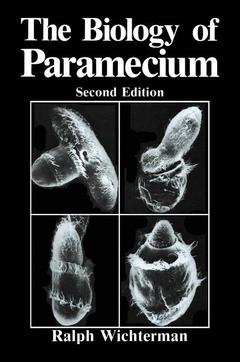The Biology of Paramecium, 1986
Langue : Anglais
Auteur : Wichterman R.

This completely revised, updated, and expanded edition has been neces sitated by the many important newer discoveries that have been made since the publication of the first edition. That volume contained almost 2000 references from the 1600s to 1953. Since then and after an extensive search, I have accumulated some 3800 additional titles from the world's literature on Paramecium. After certain titles that largely represented abstracts and preliminary reports that were followed by full research papers were eliminated, approximately 4400 full titles from the 1600s to the present were selected for inclusion in this edition. Most of the titles in the Bibliography are the more recent ones beginning with 1953. I consider the Bibliography an important part of the book: A good title of a paper in a journal is a minature abstract of its contents. Thus, the reader who may be interested in obtaining additional information not found in the book may refer directly to the original source. A cursory examination of the Bibliography will reveal that parame cium research has extended into all branches of biology, including bio chemistry and biophysics. Like other areas of science, paramecium research has become highly specialized and fragmented. I have attempted to organize and present the basic information in one book. Because of space limitations, some items may have been dealt with briefly. It is in such instances that the Bibliography will be found to be invaluable.
1 Classification and Species of Paramecium.- A. Introduction.- B. Taxonomy.- C. Genus Characteristics Emend.- D. “Aurelia” and “Bursaria” Groups.- E. Key to the Common Weil-Defined Species of Paramecium.- F. Problems in the Systematics of Paramecium Species.- G. Descriptions of the Species of Paramecium.- 2 Morphology and Cytology of Paramecium.- A. Introduction.- B. Cortex: Pellicle, Ectoplasm, and Associated Structures.- C. Endoplasm: Organelles and Inclusions.- D. Nuclei.- 3 Physical and Chemical Properties of the Protoplasm of Paramecium.- A. Introduction.- B. Permeability and Membranes.- C. Effects of Temperature and Various Agents on Protoplasm of Paramecium.- D. Effects of Space Flights Aboard Soviet Orbital Station Salyut 6.- 4 The Nutritional Requirements of Paramecium: Axenic Media.- A. Introduction.- B. Essential Neutralities and Axenic Media for Various Species of Paramecium.- C. Concluding Remarks.- 5 Nutrition, Growth, and Respiration.- A. Introduction.- B. Ingestion and Food-Vacuole Formation.- C. Secretion, Digestion, and Egestion.- D. Growth and Morphogenesis.- E. Factors That Yield Optimal Growth.- F. Respiration.- 6 Movement, Behavior, and Motor Response.- A. Ciliary Movement and Locomotion.- B. Response to Various Types of Stimuli.- C. Behavior of Paramecium and the Question of Learning.- 7 Reproduction, Morphogenesis, Nuclear Processes, and Sexuality.- A. Asexual and Other Similar Processes Involving Nuclear Reorganization.- B. Sexual Processes and Related Phenomena.- 8 Genetics: The Mating Reaction, Mating Types, System of Breeding Relationships, and Inheritance in the Species of Paramecium.- A. Introduction.- B. Inheritance in Asexual or Vegetative Reproduction.- C. Mating, Mating Types, and Inheritance in Sexual Reproduction.- D. SomeAspects of the Mating Phenomenon and Characteristics of the Mating Substance.- E. Regeneration and Morphogenesis.- 9 The Life Cycle, Longevity, and Aging.- A. Background.- B. Isolation Cultures and Clonal Aging.- C. Longevity and Clonal Aging in Regard to Autogamy, Cytogamy, and Conjugation.- D. The Question of Cyst Formation in the Life Cycle.- 10 The Antigens of Paramecium.- A. Introduction.- B. Surface Antigens and the Immobilization Reaction.- C. Serological Studies on Speciation and Conjugation.- D. Genetic Analysis: Inheritance of Antigenic Variation and Regulation of Surface-Antigen Expression.- 11 Organisms Living in and upon Paramecium: The Endosymbionts.- A. Paramecia as a Source of Food for Metazoan Animals: Their Role in the Food Chain in Nature.- B. Associations of Paramecium with Other Microorganisms.- C. Evolution of Endosymbionts of Paramecium.- References and Bibliography.
Date de parution : 09-2013
Ouvrage de 599 p.
15.2x22.9 cm
Thèmes de The Biology of Paramecium :
Mots-clés :
© 2024 LAVOISIER S.A.S.
